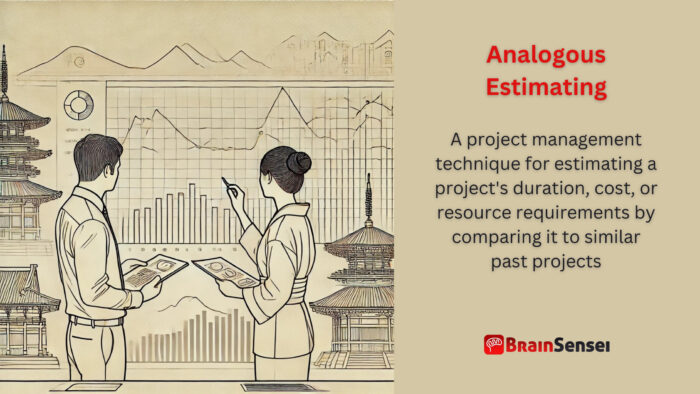
Analogous Estimating
What is Analogous Estimating?
Analogous estimating is a project management technique for estimating a project’s duration, cost, or resource requirements by comparing it to similar past projects. This method relies heavily on historical data, expert judgment, and high-level information to provide quick, early estimates when detailed project data is unavailable.
Key Takeaways
- Provides quick, high-level estimates using historical project data
- Relies on expert judgment and experience from past projects
- Best suited for projects in early planning stages with limited details
- Less accurate than more detailed estimating techniques
- Helpful in developing initial budgets, schedules, and resource plans
Understanding Analogous Estimating
How It Works
Analogous estimating works by identifying a completed project with characteristics similar to the current one. Project managers use historical data from the reference project, adjusting for differences like scope, complexity, team size, or external factors. The process requires collaboration with experienced stakeholders who can apply their insights to the estimates.
Key Steps
- Identify a similar past project as a reference.
- Gather historical data related to duration, cost, and resources.
- Adjust for key differences, such as project scale or market conditions.
- Apply expert judgment to finalize the estimate.
- Document assumptions and historical data sources for transparency.
Important Considerations
- Estimates depend heavily on the accuracy of historical data.
- The method may introduce bias if the reference project differs significantly.
- It is best applied when time is limited and a detailed estimate isn’t feasible.
- Less reliable for innovative or complex projects.
Related Terms
- Parametric Estimating: Uses statistical models and historical data to predict project metrics.
- Bottom-Up Estimating: Break down a project into smaller tasks and estimate each individually.
- Expert Judgment: Involves seeking insights from experienced professionals.
- Three-Point Estimating: Applies optimistic, pessimistic, and most likely estimates to improve accuracy.
- Historical Data Analysis: Involves reviewing past project records to inform estimates.
- Project Scope Definition: Outlines the project’s work and serves as a baseline for estimating.
Examples of Analogous Estimating in Different Industries
Manufacturing Industry
A manufacturing company is planning a new production line for a similar product. The project manager refers to a previous line setup that cost $2 million and took six months. Considering new automation tools and increased raw material costs, they estimate the current project will cost $2.5 million and take seven months.
In this scenario, the project manager consults historical records and discusses the changes with the engineering team. They identify that the automation tools will reduce labour hours by 15%, but the cost increase of raw materials offsets these savings. The team cross-references data from similar facilities in other regions to improve accuracy, ensuring their assumptions align with industry trends. The final estimate reflects the quantitative data and the qualitative input from experienced engineers.
Additionally, the team accounts for potential delays caused by supply chain disruptions, which were less of a concern during the original project. By building in contingency time, the project manager ensures the estimate remains realistic despite uncertainties.
IT and Software Development
An IT firm is developing a customer relationship management (CRM) system. They previously built a similar CRM for another client in 12 months with a team of 10 developers. The new CRM has added features but uses the same technology. Based on the prior project, the team estimates a 14-month timeline with 12 developers.
To reach this estimate, the team analyzes code reuse possibilities and interviews developers from the earlier project. They discovered that 40% of the code can be reused, reducing development effort for core functionalities. However, the new CRM requires custom modules for advanced reporting and data visualization, which the previous system did not include. After considering these factors, the estimate balances the reduced workload from code reuse with the increased effort for custom development.
The team also evaluates productivity metrics from past projects, noting that larger teams experience diminishing returns due to communication overhead. To mitigate this, they plan additional training sessions and implement collaboration tools to streamline developer interactions.
Government and Public Services
A municipal government plans to build a new community center. The last center took 18 months and cost $5 million. With updated building codes and inflation, the current estimate is 20 months and $6 million.
In preparing this estimate, the project team consults data from multiple regional community center projects. They identify trends in construction costs, noting a 20% increase in labour expenses and a 10% rise in material costs since the previous project. To account for these factors, they adjust the historical cost data accordingly.
The team also collaborates with architects and contractors who worked on the original project. These experts highlight changes in building code requirements that will complicate the electrical and HVAC systems. The updated estimate incorporates additional time and resources to address these new requirements.
Furthermore, the team includes a risk buffer to address potential delays due to weather conditions and material delivery challenges, which affected the prior project. By systematically applying lessons learned from past experiences, the project team develops a more reliable and comprehensive estimate.
Use Cases of Analogous Estimating Across Regions
United States (Construction Company)
A construction company in Texas uses analogous estimating to plan a new residential complex. They reference a similar project completed three years ago that cost $15 million. After adjusting for increased labour costs and updated building materials, they received an estimated $18 million.
The project manager first reviews historical records to understand the assumptions made in the original estimate. They notice that material costs have risen by 15%, while labour rates have increased by 20%. The team recalculates the baseline estimate by applying these factors to the historical data.
Next, the team interviewed senior site managers who had worked on the earlier project. These experts highlight challenges with subcontractor coordination and suggest implementing new project management software to mitigate similar risks. The revised estimate includes additional contingency funds to address potential supply chain disruptions.
Germany (Renewable Energy Firm)
A renewable energy firm in Germany uses analogous estimating for a new solar farm. A previous farm required 20 months for completion, but the new project will use more efficient technology. Based on the past project, they estimate an 18-month timeline.
The project team analyzes performance data from the original solar farm and consults engineers to understand the technology improvements. They learn that new panel designs and automated installation processes can reduce labour hours by 25%. However, regulatory requirements have become stricter, requiring additional documentation and testing.
To account for these factors, the team adjusts the historical data, adding time for compliance activities while reducing installation labour estimates. They then combine these adjustments with insights from external consultants to develop a robust project schedule.
India (IT Company)
An IT company in Bangalore uses analogous estimating for a mobile app project. A similar app was developed for a client in Singapore in 10 months with five developers. Given the new app’s added functionality, the team estimates 12 months with six developers.
The project manager began by reviewing the source code from the earlier project to identify reusable components. They discovered they could adapt 30% of the original codebase to the new app. However, the new app requires integrating multiple external services, adding complexity.
The team also examines productivity metrics and identifies a learning curve for the new APIs. They schedule additional training sessions and adjust the timeline accordingly to address this. The team produces a more reliable schedule by leveraging analogous estimating alongside detailed task analysis,
Best Practices for Using Analogous Estimating
Use Reliable Historical Data
Maintain an organized database of completed projects to ensure accurate and relevant past project data. The project team should also regularly validate historical data to identify inconsistencies and outdated figures.
Involve Experienced Experts
Leverage the knowledge of team members who have worked on similar projects. Their insights can reveal nuances raw data might overlook, such as contextual challenges or previously encountered risks.
Document Assumptions
Record all assumptions made during the estimating process. This documentation provides transparency and supports later reviews and lessons learned sessions.
Apply Adjustments Thoughtfully
Adjust estimates for project differences without excessive optimism. Use sensitivity analysis to evaluate how changes in key assumptions affect the forecast, ensuring a balanced approach.
Regularly Update Estimates
Refine initial estimates as more project information becomes available. This iterative approach helps maintain realistic and reliable forecasts.
Conduct Post-Project Reviews
After project completion, compare actual outcomes with initial estimates to assess accuracy. Identify patterns of errors and successes to improve future analogous estimating efforts.
Integrate Estimating Software Tools
Use modern project management tools to store historical data and automate certain aspects of analogous estimating. Tools with machine learning capabilities can improve estimate accuracy by identifying patterns across multiple past projects.
Balance Expert Judgment with Data Analysis
While expert input is valuable, the project team should complement it with objective historical data. This balance helps reduce biases arising from overconfidence or subjective perspectives.
Educate the Team on Estimating Practices
Provide regular training sessions to keep the team updated on best practices and emerging trends in estimating techniques. Knowledgeable teams are better equipped to apply analogous estimating effectively.
Potential Issues
- Inaccurate estimates due to differences between past and current projects
- Overreliance on expert judgment without supporting data
- Failure to document assumptions leads to confusion later
- Inconsistent data quality across historical records
Common Mistakes and Issues
While analogous estimating is a valuable tool in project management, it can also have potential pitfalls. Understanding these common mistakes can help teams avoid costly errors and improve estimation accuracy.
Assuming Projects Are Identical
One of the most frequent mistakes is assuming two projects are identical when, in fact, they have significant differences. For instance, a construction company estimated the cost of a new office building using data from a previous project without accounting for increased labour costs and new building codes. As a result, the project exceeded its budget by 20%. Constantly adjust for differences in scope, location, market conditions, and regulatory requirements.
Overreliance on Expert Judgment
While expert judgment is crucial, overreliance on a single individual’s perspective can introduce bias. Experts may base their estimates on outdated information or personal experiences that don’t fully apply to the current project. A diverse group of experts should be involved to mitigate this potential issue and cross-reference their insights with historical data.
Inaccurate or Incomplete Historical Data
Using historical data that is inaccurate, incomplete, or outdated can skew estimates significantly. For example, a software company estimated project duration using data from an old system without considering new development tools that speed up coding. To avoid this mistake, maintain a well-organized database with regularly updated project data.
Neglecting Risk Factors
Ignoring potential risks and assuming best-case scenarios often leads to cost and schedule overruns. For example, a manufacturing firm once estimated production setup time based on a previous project without accounting for potential supply chain delays. Including contingency buffers and conducting risk assessments can help prevent such issues.
Failing to Document Assumptions
A lack of documentation regarding the assumptions made during estimation can confuse later. When team members change or review past estimates, undocumented assumptions may lead to misinterpretations and project delays. Establish a standardized documentation process for all estimation activities.
Misapplying Data Across Different Contexts
Historical data from one context may not apply directly to another. For example, a telecom company used data from an urban network expansion project to estimate costs for a rural deployment. The differences in terrain, labour availability, and infrastructure requirements resulted in significant cost overruns. Contextual differences must be thoroughly analyzed before applying analogous estimates.
Avoiding these mistakes requires a combination of diligence, collaboration, and the continuous improvement of estimating practices.
Frequently Asked Questions (FAQs)
How accurate is analogous estimating?
Analogous estimating provides high-level estimates with moderate accuracy, often within 25-50% variance, depending on project similarity and data quality.
When should I use analogous estimating?
Use it during early project planning when detailed information is unavailable and a quick estimate is needed.
What are the limitations of analogous estimating?
This technique relies heavily on historical data and expert judgment, making it less accurate than parametric or bottom-up estimating methods.
How can I improve the accuracy of analogous estimates?
Ensure historical data is accurate, involve experienced stakeholders, and adjust for differences in scope, technology, or market conditions.
Is analogous estimating applicable to all industries?
It’s adaptable across construction, IT, manufacturing, and government services.
Can analogous estimating be combined with other methods?
Absolutely. Parametric estimating or expert judgment can complement analogous estimating for improved accuracy.
Additional Resources
Preparing for a PMI certification?
- Exam Prep Courses: PMP®, CAPM®, and PMI-ACP®
- Exam Simulators: PMP®, CAPM®, PMI-ACP®, PMI-PBA®, PMI-RMP®, PMI-SP®, PgMP®, and PfMP®
- Professional Development Units (PDUs): 15, 30, and 60 PDU Bundles



